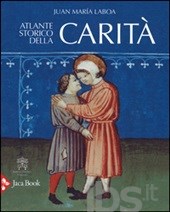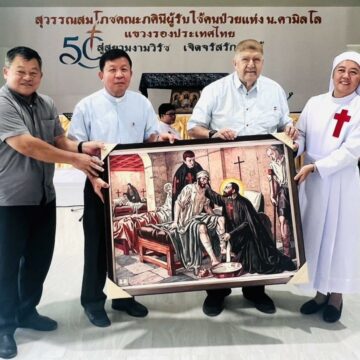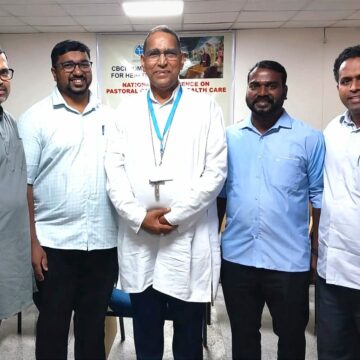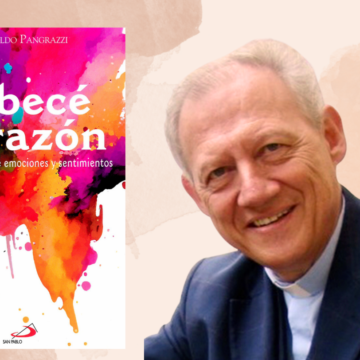ATLANTE STORICO DELLA CARITÀ
 The author of this book is the Spanish priest and historian Juan Maria Laboa and this work, which is splendid as regards its iconographic apparatus as well, provides the reader with an opportunity to ask himself in a serious way about what it means to be a Christian in daily life. The final chapter is on Francis and sees him as a Pope who is a ‘break with the past’.
The author of this book is the Spanish priest and historian Juan Maria Laboa and this work, which is splendid as regards its iconographic apparatus as well, provides the reader with an opportunity to ask himself in a serious way about what it means to be a Christian in daily life. The final chapter is on Francis and sees him as a Pope who is a ‘break with the past’.
‘It is thrilling to see that at every moment, in every place, men and women have come together with a surprising readiness to help and imagination in order to bring forth a happier humanity, one more inspired by solidarity and nearer to God and His creatures, in projects that embrace all the manifestations of life, from the most tender childhood to caring for the dead’.
Published by the Libreria Editrice Vaticana and Jaca Book, this is a volume which, independently of one’s full or only partial agreement or disagreement with the author – the Spanish historian Juan Maria Laboa – is objectively of great value and deserves to be present in the library of every Catholic parish, religious community and Catholic association. Its title is ‘A Historical Atlas of Charity’ and on its cover is a miniature of ‘St Francis and a Poor Man’ (from a manuscript of the fourteenth century of the Legenda Maior of St. Bonaventure). The text is divided into forty-one chapters (with an introduction, an appendix and notes) accompanied by reproductions and photographs of deep meaning and great beauty from all kinds of sources.
In the introduction Loboa already points out the direction that he will takes, saying clearly: ‘The Church that (Christ) proposed to us cannot be reduced to a temple, a sacrifice, a commandment or an organisation, which characterise a religion, but, rather, it involves fundamentally a people that loves itself, a community that is marked out by its fraternity and its solidarity’. Here one can but see the full consonance of Laboa with Pope Francis.
This Spanish historian goes on: ‘I have always thought that a history of Christians and the Church that is not centred around the ability to love one another and to love other human beings escapes the central core of the believing community and the institution of the Church. This history, however, has still not been undertaken and achieved’. And later, in the second chapter (‘The Parables of Jesus’), Laboa observes that: ‘The history that we read and know corresponds in general to that of famous figures, politicians, intellectuals, Popes and saints. But the world has moved on, above all thanks to innumerable unknown people, to citizens without a name, who through their modest and silent work have made sure that the often difficult and ungrateful lives of peoples improved’.
A great deal more could be said about this ‘Atlas,’ in whose chapters are to be found, amongst other things, the deaconate and martyrdom, Julian the Apostate and the Fathers of the Church, wandering missionaries and monasticism, the Virgin Mary and St. Francis of Assisi, words of mercy and the education of the poor, Helder Camara and Oscar Arnulfo Romero, worker priests and Mother Teresa, Caritas and Pope Francis. To induce the reader, here are some presumably interesting passages taken from one chapter or another.
The feast day of collections and the institution of the public granaries during the early centuries. The Church obtained what it needed for its charitable works thanks, in fundamental terms, to collections amongst the faithful. The most well known was, without any doubt, the ‘feast day of collections’, one of the events that was dedicated each year to collecting a notable sum sufficient to meet the needs of poor people of all kinds who were present in the diocese…Christian Rome approved and fostered the creation of public granaries for feeding the lower classes. In these granaries corn was not sold – it was stored and distributed to those in need. The agricultural lands that the Roman Church possessed in Africa and Sicily were administered by representatives of the Bishop of Rome and their mission was to send the harvests to Rome’.
The Church, power, conversion: if we reflect on this story (editor’s note: of Julian the Apostate) we realise that conversion of power in all its dimensions was very difficult. Christianity was accepted as a personal religion but government continued to be selfish, violent, unthinking and aggressive towards anybody who was seen as an adversary or a competitor. The Capetians, the Bourbons, the Hapsburgs or the Braganzas supported the Church and even had personal piety but they nearly always believed that the end justified the means.
Charity also during the darkest periods: even in the darkest epochs of the life of the Church, when its organisation had been contaminated by all the forms of corruption and violence that were present in the other strata of society, we encounter the fruits and the consequences of the gospel mustard seed which bore fruit in the hearts of the most unthinkable people who at first sight were the least involved or least disposed to help.
The barbarian peoples and Western civilisation: the barbarian peoples were a great threat to the Empire; in contrary fashion, for Christianity they constituted a new opportunity to extend the kingdom of Christ and ensure that other peoples knew about the call and the project of God…This is the story of Clodoveus and the Franks. of Recaredus and the Visigoths, of St. Martin and the Suebians, of Theodolind and the Ostrogoths.
The beginnings of Western civilisation have to be looked for in the community of different peoples united by Christianity that had been formed at the moment when the Roman Empire collapsed, and following the conversion of the various barbarian peoples to Christianity.
The colonial contradictions: the invasion and the colonisation of so many peoples by the Christians probably constituted the most painful reason for contradiction, but also the most fascinating one, in Christian history. These Christians demonstrated in their actions and their relations with the inhabitants of the conquered lands the connection between sin and grace, faithfulness and inconsistency, and fraternity and selfishness. The Christian presence introduced at the same time greater respect for the human person, higher levels of education and coexistence, a purer idea of morality, a more sublime and beneficial notion of religion and, equally, voracious oppression, manipulation and selfishness that was no greater than what they had endured in the past but more unjust and unacceptable.
The Inquisition and charity: the Inquisition, albeit providing all the explanations that it is possible to give of it, was in contradiction with a religion that defends freedom of faith and relationships based upon fraternity and the mutual love of its members. Although in the historical memory only the Spanish Inquisition has remained, the truth is that the attitude and the machine of the Inquisition remained active in all the Christian Churches while in the Catholic Church its organisation worked for four centuries.

Nicola Sangiorgi, s.Camillo trasporta un malato durante la peste a Roma, bulino, XIX secolo ( AGMI, A 37)
The treasures of the Church: the treasures of the Church, the gold and precious stones, and the sumptuous liturgical ornaments of churches and cathedrals raise a grave question about their necessity and the waste that they involved in situations in which far too many people only just had enough to survive. The argument that for God nothing is excessive is fallacious. Christ chose not to have anywhere to rest his head and it is unacceptable that his faithful are inactive in the face of the abject poverty of their brethren while the vases of the temple are made of gold and precious stones
The gravest temptation against charity: the gravest temptation against charity is mediocrity. Because of being lukewarm, so as not to be cold or hot, out of a fear of losing what seems to give security and confidence, people feel the need not to be exposed, not to fall into ridicule, and not to allow themselves to be known for what they really are. This is the temptation to hide oneself behind law, behind rules, behind tradition, in order to free oneself from the need to be generous, creative and radical in the expression of faith…Indeed a mediocre person, one who is not very humble, is unable to listen. He hides behind some traditions of the past because he does not feel able to respond with greatness to today’s signs of the times.
Unjustly persecuted by the Church: the histories of those who have suffered or have been marginalised for defending ideas that would later be accepted, or would have had a positive influence on the life of the Church, are striking. We may think of the problems of conscience that Savonarola had when he denounced Alexander VI, an often unworthy Pope. Could he keep quiet in his intransigent search for a purer and more evangelical Church given the example set by Alexander, his family and his Curia?…More than one saint was put in prison, in the secret rooms of the Sant’Uffizio as well: St. John Avila, Cardinal Morone, St. John of the Cross, St. Ignatius de Loyola, St. Joseph Calasanz, St. Louis Marie Grignion de Montfort and very many others, certainly not for objective reasons but because of the pride, the intransigence and the ignorance of their persecutors…One should also remember the not infrequent case of founders of religious Orders who were marginalised by their own disciples. They are the great ‘difficult’ Christians because of their consistency and evangelical radicality, like St. Francis, and because of their simple honesty, like Guillaume-Joseph Chaminade, or because they clashed with the interests and the examples of selfishness of their successors, like St. Raphael of the Sacred Heart.
Pope Francis/1: at a moment of dismay and generalised lack of hope in many Christian contexts, to the surprise of people Francis appeared, the Pope who came from distant lands, an exotic figure for a Christianity that remains rather European and Western. The new Pope took the name of Francis, incompatible with pomp, the pride of eyes, distance from our brethren, from human power and glory. No Pope had had the audacity to adopt this name, aware of the commitment that it would have meant. Popes could not have the same name as the ‘poor man’ of Assisi while living in a palace, going around in splendid cares, with a court of functionaries, attendants, gentlemen in evening dress and submissive bishops. In reality it is very difficult to accept someone calling themselves the vicar of Christ, who died on a cross to complete a life of pure abandonment to, and hope in, the Father, and at the same time living surrounded by so much theatricality. Indeed this contradiction has been manifested not only in Popes but also in the majority of Christians…
Pope Francis/2: there is the impression that Pope Francis, as the Second Vatican Council did, intends to invert the priorities that are often dominant in the Church, abandoning the unceasing reference to ecclesiastical institutions, to their authority and efficiency, as the centre and yardstick of faith and the Church, and converting the Christian community into a space of communion and welcome…The ordinary people of the world like this and this explains why Francis is seen as ‘one of us’, as a Roman taxi driver said a few days after his election…In abandoning the throne, in reducing distances, in sitting at the same bench as the faithful, in continuing to live in an outhouse, in rejecting luxurious cars, and in mixing with his brethren, Francis not only does not diminish his own prestige or his authority but puts things in their right place and reminds us with simplicity of how Jesus acted.
“ATLANTE STORICO DELLA CARITA”, UN TESTO DI SPESSORE – di GIUSEPPE RUSCONI –HYPERLINK “http://www.rossoporpora.org/”www.rossoporpora.org – 30 September 2014














Camillians on Facebook
Camillians on Twitter
Camillians on Instagram